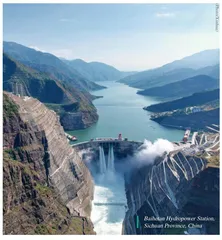Global Clean Energy Transition and China’s Role
作者: Li Xinlei

The world today is undergoing profound changes unseen in a century. A raft of crises, including climate change, soaring energy price and sluggish economic growth, are dragging behind the achievement of the UN 2030 Sustainable Development Goals. Clean energy represented by wind, solar, biomass and green hydrogen, as the mainstay of next generation energy economic system, provides an overall response to these crises. As fossil energy consumption accounts for more than 70 percent of global greenhouse gas emissions, the core of energy transition is to replace fossil energy with clean one and decouple carbon emissions from economic development. As major countries are ramping up competition in today’s world, the global clean energy transition presents new development trends and is confronted with multiple challenges. In such process China is playing an essential role and is increasingly becoming a leading force.
New Trends in Global Clean Energy Transition
Recent years have seen rapid technological innovation, fallen costs and increased application scenarios for clean energy. It has gained greater potential in addressing climate crisis, guaranteeing energy security, ensuring energy accessibility, and spurring green recovery.
I. Clean energy transition becomes the core solution to climate crisis in the context of global carbon neutrality
According to the Sixth IPCC Assessment Report in 2022, the global climate is changing faster than previously expected, many ecological areas are approaching their critical points, and the average temperature increase of global surface will reach or exceed 1.5℃ in the next 20 years. Against this backdrop 139 countries, 116 regions, 241 cities and 804 companies in the world, which account for 90 percent of global GDP and 88 percent of total greenhouse gas emissions, have set carbon-neutral targets by the end of 2022. All countries give top priority to decarbonization in energy sector in their medium and long-term road maps to achieve carbon neutrality. Moreover, through increased investments they aim to develop clean energy such as wind, solar, green hydrogen, nuclear and biomass, as well as related green industries such as green transportation, digital energy storage technology, industrial decarbonization technology and sustainable infrastructure.
The International Energy Agency noted that despite supply chain disruptions, transport delays and component price spikes due to COVID-19 and regional conflicts, newly added renewable capacity increased by 17% in 2021 to a record high of 314GW, in particular, renewables’ share of net new power reached a record 84%. As of October 2022, 183 of the 193 Parties to the Paris Agreement on climate change had included renewable energy in their Intended Nationally Determined Contributions; 143 of them made it known their quantified clean energy development targets. In November 2022, the COP27 meeting in Sharm el Sheikh of Egypt put loss and damage on its agenda for the first time and highlighted the need to enhance climate adaptability and governance resilience of vulnerable countries through the development of clean energy.
II. Clean energy is seen as an important green engine for post COVID-19 economic recovery
Many countries are taking green recovery as an opportunity to nurture new competitive advantages in the post COVID-19 era. They are keen to develop key green and low-carbon technologies and foster green industries. The EU, US, Japan and others have all put forward a package plan for green recovery by devoting more investment to clean energy research and development and market expansion. In particular, as the green and digital transition becomes ever more prominent, investments and R&D in new digital technologies such as smart grids, smart energy storage, the Internet of Things, big data and artificial intelligence have increased the share of clean energy used in emerging smart power generation and distribution systems.
According to the IEA’s Global Energy Investment 2022 report, clean energy investment in 2022 exceeded US$1.4 trillion, accounting for nearly three quarters of total energy investment growth in 2022. Renewables, grids, energy efficiency improvements and storage accounted for more than 80% of total investment in power sector. Meanwhile, the booming clean energy industry has brought more jobs and investment opportunities. The International Renewable Energy Agency (IRENA) stressed that people employed in clean energy sector worldwide continue to grow from 12 million in 2020 to 12.7 million in 2021, despite a sluggish global economy. The Agency predicted that if the energy transition measures are in line with the 1.5℃ cap on global warming, 85 million new jobs will be created by 2030 (compared with 2019), far more than the jobs lost in fossil energy.
III. The energy crisis caused by geopolitical conflict has accelerated the pace of global clean energy transition
The Ukraine crisis has caused acute fluctuation in energy market, with high fossil fuel and electricity prices triggering an energy crisis centered in the EU and gradually rippled across the world. Energy security concerns have prompted countries to turn to solar, wind and other clean energy for the purpose of supply diversification, in order to reduce dependence on imported fossil fuels whose price has soared. Adding to that, competitive advantages of clean energy have emerged thanks to technological innovation, manifested by the power generation costs falling by 85%, 68%, 54% and 45% for photovoltaic, solar thermal, onshore wind and offshore wind respectively from 2010 to 2020. Clean energy is becoming more economically attractive and showing stronger momentum for development than ever before due to its economic attractiveness. According to the IEA, the global installed renewable energy capacity is expected to nearly double to 2,400GW between 2022 and 2027, and renewables are expected to take up more than 90% of global power expansion, overtaking coal as the world’s largest source of electricity by early 2025.